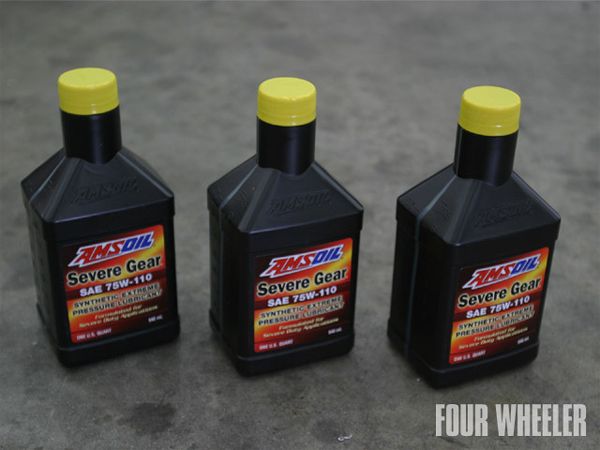
Gear Lube or ATF for NP205?
I’ve always been told to run 80W-90 gear oil in my transfer case (NP205), but recently I’ve had my transfer case rebuilt, and when I went to drain it and put some fluids in it, tranny fluid came out. It seemed to be the same Dextron 3 I run in my transmission, so I called around and got people who were sure it was tranny fluid and people who were sure it was gear oil, but I wanted to ask some fellow four wheelers who know from trial and error.

Which should I run: transmission fluid, or 80W-90 gear oil? It is the original transfer case on my ’72 Chevy . . . yeah, it’s old.
Chim Chim
Via fourwheeler.com
The NP205 and NP200 take just what you have been told to use—75W-90 gear lube, about 4.5 pints. The same goes for any of the Dana-series cases like the 18, 20, and 300. The NP203 with its chain drive, however, is designed to use 10W-40 engine oil, and I always recommend using a synthetic lube.
For those of you wondering about other transfer cases, most all of the New Process/New Venture cases take ATF. Here again, I recommend a synthetic lube. Rebuilders tell me a better lube is 5W-30 engine oil, and that is what I use.
Oh, and you may find some factory reference to using 50-weight engine oil in the NP205 as well as the Bronco version of the Dana 20. I’ve have even had people tell me that all Dana transfer cases can run 50W engine oil. In reality, it has about the same viscosity as a 90W gear lube with a different additive package.
Wants Ranger Torsion Key Lift
I was looking at a torsion key leveling kit for my ’06 Ranger 4x4 Sport. I want bigger tires, but I don’t know what the ride would be like afterwards. Rangers are kind of rocky from stock (side to side). Has anyone done this to their Ranger? I was thinking of 32x10.50 BFG tires.
06ranger4x4
Via fourwheeler.com
Yes, the torsion bar key leveling system will work on your Ford Ranger. You’re thinking right by using a 32x10.50-size tire. Put it on an 8-inch-wide rim that has 4.5 inches of backspacing. ReadyLift has what you will need (www.readylift.com).
As to ride quality, well, it will suffer due to limited downward wheel travel. To control the “rocky” ride, I suggest a gas-pressure shock like a Bilstein 5100 or perhaps some adjustable shocks like the Pro Comp MX-6 or the Rancho RS9000.
Death Wobble Mystery Solved Forever! Or Not
In the Mar. ’11 Techline, Lou Keller of Cuyahoga Falls, Ohio, asks for help with a “death wobble.” This event is more common than is realized. Mechanics have been chasing this problem with altered vehicles for a long time, and spend lots of the customer’s money experimenting to see if they can solve the issue, often leading to less wobble but seldom to no wobble. The problem always shows itself after a lift kit is installed. Sometimes, changing the tire size or pressure will reduce the problem, but not entirely solve it. Toe-in is not the problem—this will cause premature tire wear and wandering, not wobble. Camber will not cause it, though it does have some effect due to the changing of tire size that usually accompanies the lift. Changing tire size changes the point at which the line between the upper and lower ball joints intersects the pavement in the tread pattern unless careful attention is given to the offset of the wheels to keep the line where the factory designed it to be.
Out-of-balance tires and wheels do not cause it. Worn-out parts do not cause it—you can drive a vehicle with worn-out unitized hubs, worn-out ball joints, worn-out steering linkage, the wrong camber and improper toe-in, and all that will happen is poor steering control and premature failure of tires.
The root cause of “death wobble” is always related to the caster angle of the front axle. Too much or too little can cause it, and the speed at which it occurs upon hitting a bump in the road is determined by the amount it is off. Remember the days (if you are old like me) of extreme choppers with very long rake angles? They often experienced the same problem. Even a shopping basket at the grocery store will experience some degree of wobble after the front wheel has been hit enough to change the angle of the caster. Trucks with lifts are notorious for having this problem because we like to lift them to make room for bigger tires.
Not all lift kits are created equal. Not all manufacturers put the time into engineering the proper caster into the kit. Many simply design the kit for lift and clearance without thorough testing with different wheels and tires. It is often assumed that the factory specs are good enough, but that is sometimes not the case. Caster has a limited range in which it works; again, too much or too little, and you have problems. Yes, it is important to have everything else correct as well for the safety of all involved, but it is caster that is the root cause of the problem. Find the correct caster angle for the combination of lift, wheel width, and tire diameter, and the problem will go away. Been there, done that many times. Hope this helps. I’ve been reading queries like this for years in many magazines, and the expert always takes a shotgun approach to the problem when surgical-precision rifle shots are what are needed.
Gary McClenny
Irving, TX
I always appreciate readers expressing their opinion of Techline or Willie’s Workbench. At least it lets me know someone is reading what I write.
Sorry, but I have to take exception to several of your statements regarding the causes of death wobble. Yes, caster angle is a very big player when it comes to the problem. Generally speaking, when a lift is installed on a solid-axle vehicle, the angle of the front driveshaft is increased, often to the point of either causing U-joint binding at full droop or a vibration in the shaft. It seems that the usual solution is to turn the housing to raise the pinion higher and reduce this angle. The big problem is that when the housing is turned upward, the caster angle at the steering knuckle is reduced.
The proper solution is to cut the steering knuckles loose from the axletubes, and then re-weld them at the proper angle—not an easy fix. In some instances, an offset ball joint can be used to somewhat solve the problem if the caster angle change is not too extreme. It seems that most people kind of reach a compromise between proper pinion angle and caster angle. On IFS vehicles where the differential is usually lowered, not only to improve driveshaft angle but to lessen the angle of the CV joints on the connecting shafts, caster angle is corrected by use of shims or offset ball joints on the steering knuckle. However, I have never seen a case in where excessive caster angle is the cause of a wobble. It is the lack of caster that contributes to the problem. Land speed-record vehicles and dragsters use an extreme amount of caster angle to help them track in a straight line, and experiencing a wobble at high speeds is “death.”
When trying to solve a wobble problem, a shotgun approach is always needed, especially on a vehicle that has accumulated a considerable amount of miles. One needs to always look at the overall condition of every component that is involved. This does include things such as the condition of the tie-rod ends, steering box play, track bar ends, ball joints or kingpins, and wheel/tire balance. Any worn component can contribute to a wobble, and often it is the culmination of several things contributing to the problem Yes, you’re correct in saying that toe-in does not have any effect on the wobble, but the large tires will have more of a “push” outward, so most experienced alignment shops will add a bit more of toe-in to ensure proper tire wear. The main point here is that larger tires and wider rims will definitely cause a change in everything from scrub radius to the load on steering components.
Let’s take a quick minute here to discuss what is called Steering Axis Inclination (SAI). This is the angle from vertical of the axis about which the front wheels rotate. Look at a front axle and you will see a ball joint at the top and one at the bottom. Draw a line in your mind between the two. This is the SAI. Continue with this line down through the tire to the point where it meets the ground. This is what is called the “scrub radius.” If the point of intersection of this line with the road is in the center of the tire, it is called a neutral scrub radius and is ideal. If it is outside the center of the tire, it is referred to as negative scrub radius. A bit of negative scrub will create a force toward the center of the vehicle, and tends to make the vehicle more stable. If the line hits the road inside the centerline of the tire, we have positive scrub radius. A neutral scrub radius is the ideal, as it gives the best tire wear and the easiest steering. When you go to a taller tire, the scrub radius has a tendency to go negative but usually one also goes with a wider rim and increases the tire width and perhaps a bit less backspacing on the rim for additional clearance, so the scrub radius goes back to neutral. When one reduces the amount of backspacing a considerable amount—such as using a rim designed for a solid axle with, say, 3.75 inches of backspacing on an IFS frontend which originally had a back spacing of, say, 5 inches—all sorts of geometric problems develop.
Due to clearance issues, it is not always possible to maintain the same factory wheel backspacing. Setting a wheel in a wider stance is just like adding a lever arm that causes an exacerbating effect on all the components. I can speak from experience that worn kingpin bearings or out-of-balance tires will definitely cause a “death wobble.” I am not trying to take anything away from your opinion but expressing my view and experiences based on over 50 years of working on 4x4 vehicles.
Where To Write
Address your correspondence to: Four Wheeler, 831 S. Douglas St., El Segundo, CA 90245. All letters become the property of Four Wheeler, and we reserve the right to edit them for length, accuracy, and clarity. The editorial department can also be reached through the website at www.fourwheeler.com. Due to the volume of mail, electronic and otherwise, we cannot respond to every reader, but we do read everything.